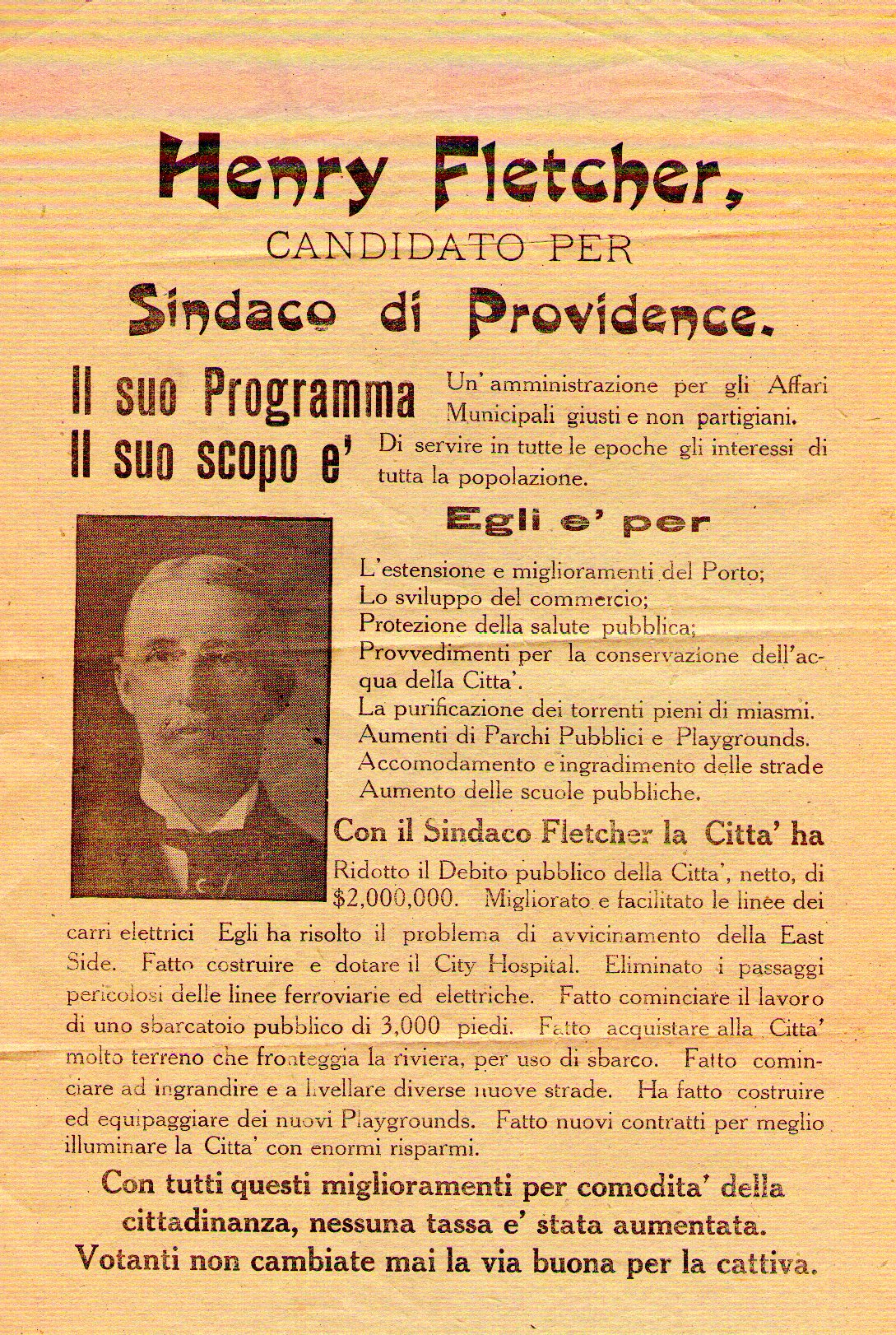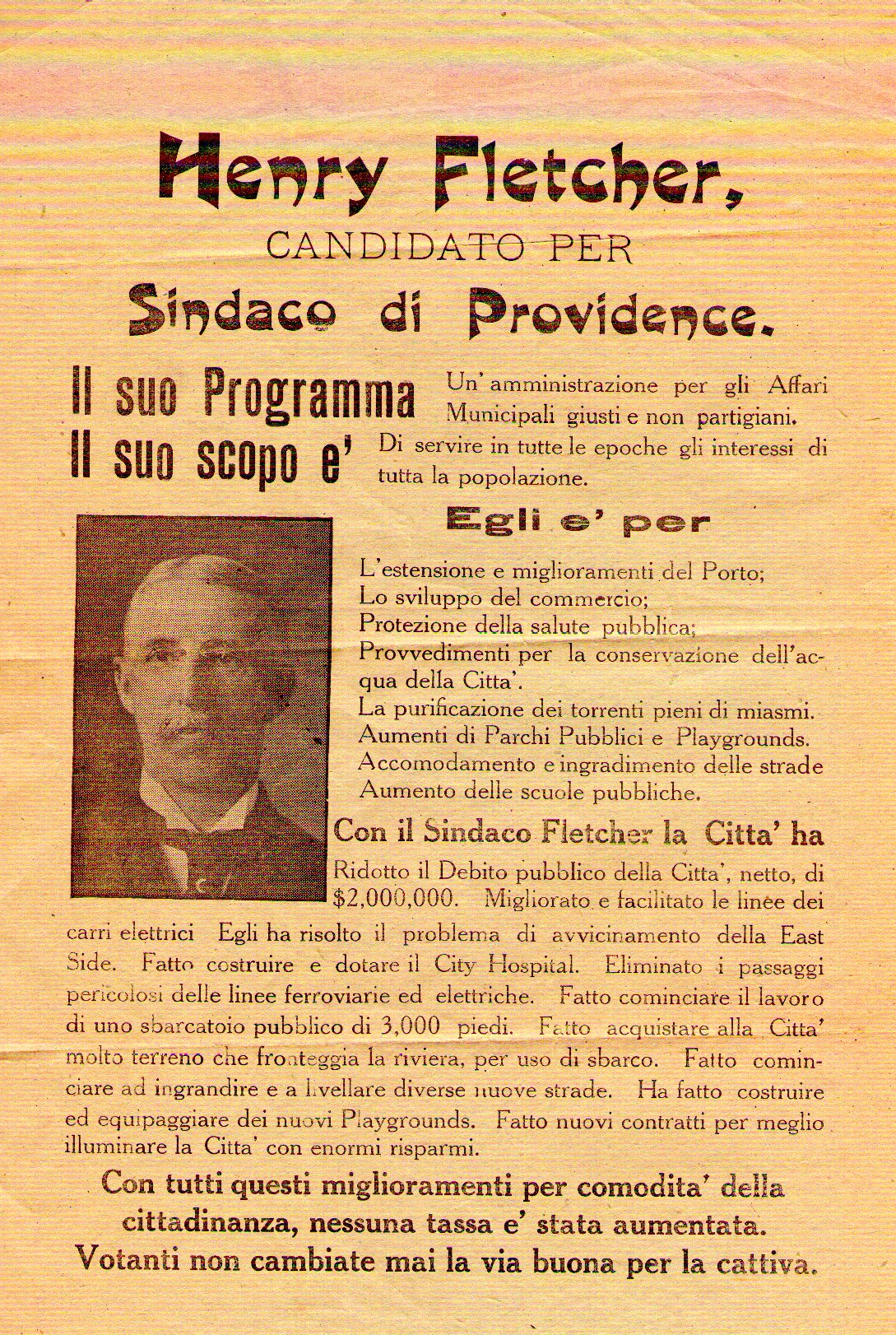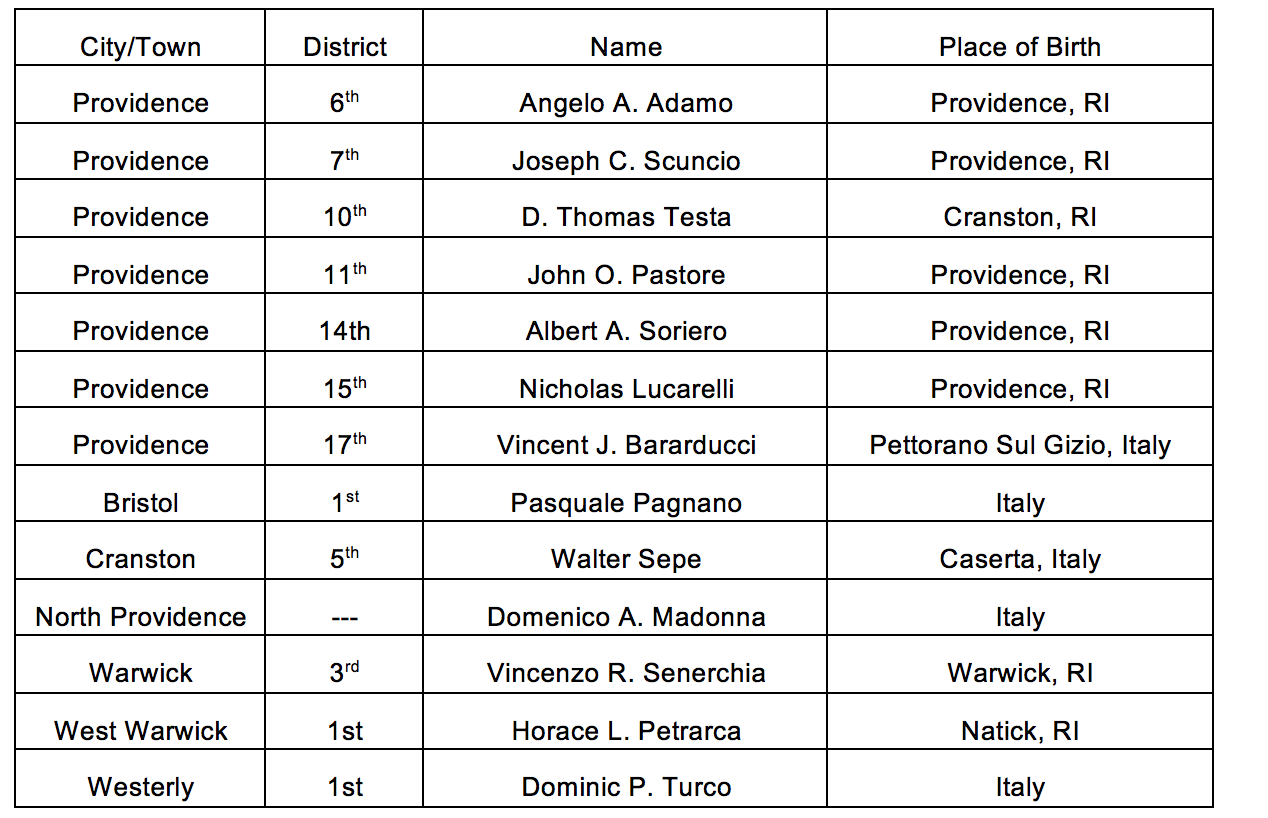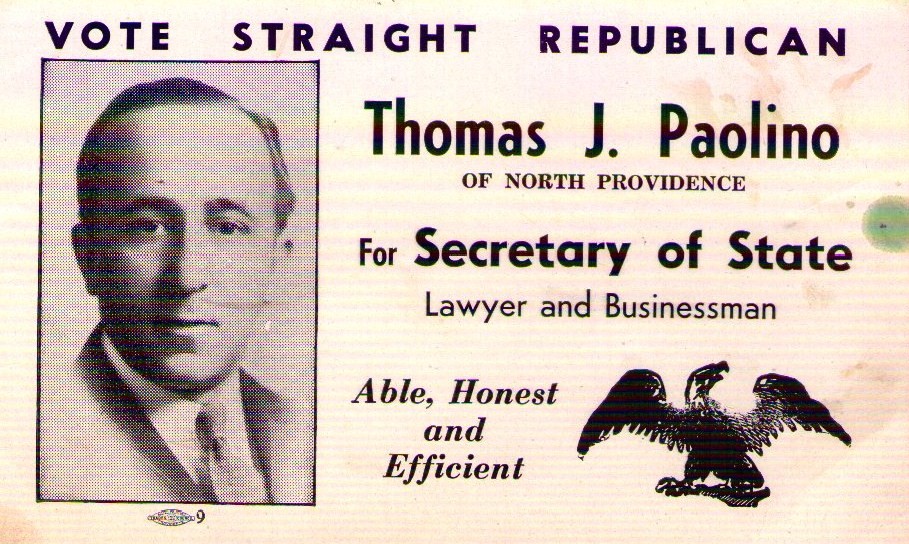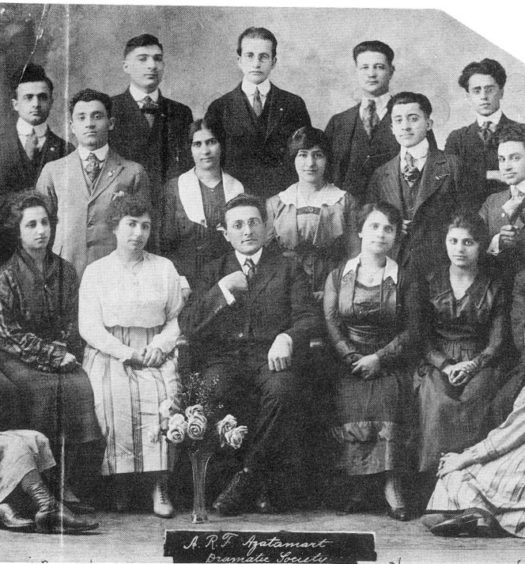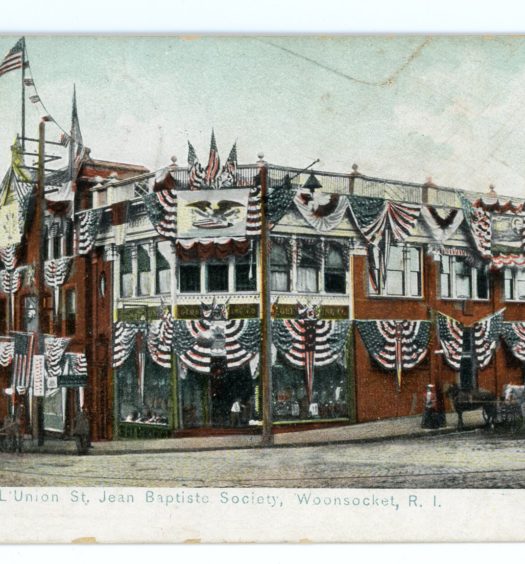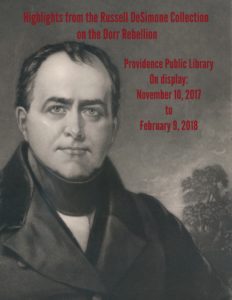The hallmark of a great democracy is that its leaders reflect the composition of the electorate. It has been the case that for each new wave of immigrants the first ten years, more or less, are spent getting settled and acclimated to a new and sometimes unfriendly environment. In time these new arrivals often seek United States citizenship. These newly made Americans did not usually run for political office; but some did, as would their children and their children’s children. This has proven to be the case not only for Italo-Americans but also for Irish-Americans and Franco-Americans who came before, and the Portuguese-Americans and Hispanic-Americans who came after. It is true for all the nationalities that have arrived on America’s shores. In a sense it is an indication of a well working democracy and is American as apple pie.
While it is true that some Italians began immigrating to America as early as the 1860s—in fact Providence had a small colony of Italian artisans by the late 1860s—but it wasn’t until the period from 1890 to 1910 that large-scale immigration occurred. Once settled Italo-Americans through the process of naturalization became United States citizens. Upon achieving citizenship, adult males could register to vote; however women would not participate in the electoral process until the passage of the 19th amendment to the United States Constitution. Women in Rhode Island first voted in state elections in November, 1920.
The first inroads into elected office for Italo-Americans occurred in Providence during the first decade of the 20th century. Providence by 1900 had a sizable Italian immigrant population, so it is no surprise that the first Italo-Americans elected to public office came from those city wards where there were numerous Italians. The first elected office attained by an Italo-American in Rhode Island was to the Providence Common Council. In the election of November 8, 1904, Henry Taylor was elected to office from the 9th ward; Taylor, born Enrico Tella, had Anglicized his name, presumably the name change increased his acceptability by the non-Italian voters. Taylor was elected as a Republican to the Common Council and stayed in that office until 1910 when Vito Famiglietti was elected as 9th Ward Councilman. In the election of 1904 two other Italo-Americans also ran for office. Angelo DePasquale, a Democrat, ran for state representative from Providence’s 11th Ward but lost to Republican George L. Pierce, and in the race for Providence 3rd Ward school committeeman the Republican candidate Parrillo [no first name provided] lost to his Democratic rival, John W. Hogan.[1] DePasquale ran a second time in 1908 for state representative from the 11th Ward only to lose again.
While the election of 1904 marked a significant milestone, it being the first time an Italo-American was elected to office, it was not the first time that an Italo-American ran for office. In the November 1903 election Adamo Aiello a Democrat from Providence’s 9th Ward ran for City Council but the four seats to the city council from this ward were all won by Republicans.
Of course, even before most Italo-Americans thought of running for political office, their votes were solicited by both the Republican and Democratic parties. As an example Figure 1 is a handbill printed in Italian for Henry Fletcher for mayor of Providence. Fletcher was first elected mayor in 1908 narrowly defeating Democrat incumbent mayor Patrick J. McCarthy by just 255 votes. Obviously every vote was important and in the early years of the 20th century Italians were as likely to favor Republican candidates as much as Democratic candidates. It would not be until the second half of the second decade of the 20th century before most Italians would identify with the Democratic party.
Three years following DePasquale’s failure to gain a seat in the House of Representatives, Adamo Aiello successfully ran as a Democrat from the 17th district. Soon thereafter other Italo-Americans, both Republicans and Democrats, would run and be elected. By 1920, in addition to Aiello, Peter Caldarone, Sivlerio Giannotti and Luigi DePasquale had all been elected; all were from Providence’s heavily Italian 14th and 17th districts. It would not be until 1923 that an Italo-American would be elected to the House of Representatives from a town other than Providence. That year Michael Turano, a Republican, was elected to the House of Representatives from Westerly’s 1st District. Leadership in the House would take much longer to attain; the first Italo-American Speaker of the House of Representatives was Joseph A. Bevilacqua, a Democrat, who served as speaker from 1969 to 1976. Since then two others have served, Joseph DeAngelis from 1988 to 1992 and Nicholas A. Mattiello from 2014 to the present.
Election of an Italo-American to the Rhode Island Senate would require more time also. In fact it was nearly a quarter of a century after the election of Adamo Aiello to the House of Representative that Luigi DePasquale was elected Senator from Providence’s 4th Senatorial District in 1935. The reason for such a long wait can best be explained as party politics. Both the Republican State Central Committee and its counterpart the Democratic State Central Committee decide who will run for which office under the party banner. By 1935 there was significant pressure to place Italians in office as the Italian community demanded it. In the following election cycle DePasquale, a Democrat, was replaced in the same Senate seat by Samuel Scalera, also a Democrat. Things were changing in another sense in that more and more Italo-American candidates were American born. DePasquale was born in Providence but Scalera was from Ceserta, Italy. Interestingly when DePasquale was elected to the Senate, the House of Representative had thirteen Italo-Americans representing seven different towns – a significant advance from the 1911 election (see Table 1 below). While more than one-third of these representatives were born in Italy, as time marched on, fewer and fewer Italo-American politicians would be foreign born. An appendix to this study, not provided here due to space limitations, but available at: http://italoamericanclubofri.com/Political-Pioneers/mobile/index.html provides a detailed look at the shift from Italian born to American born elected Rhode Island state officials between the years 1910 and 1950.
The Rhode Island Senate had traditionally been presided over by the Lieutenant Governor but in 2003 that changed when a new provision to the state constitution allowed for the Senate to elect its own President. To date there have been only three Senate Presidents. The second person to serve in that capacity was Italo-American Joseph Mantalbano who served from 2004 to 2009. The first Italo-American to serve as Senate Majority Leader was Frank Sgambato; he served in this capacity from 1963 – 1972. Sgamboto was followed by Rocco A. Quattrochi from 1980 – 1983.
The first Italo-American elected to statewide office was Louis W. Cappelli; he graduated from both Brown University and Yale Law School. He first ran for Secretary of State in 1930 but lost to Republican Ernest Sprague. In 1932 he ran again and was elected. He served as Secretary of State for three full terms, being elected again in 1934 and in 1936. He finally lost a re-election bid in 1938 to J. Hector Paquin during a Republican sweep of state offices. Figure 2 depicts a palm card handed out at polling places from any one of the four times he ran for office. Cappelli was a true trailblazer in the Italo-American community; in 1940 he became the first Italo-American elected to the office of Lt. Governor. He was elected two times as Lt. Governor but in April, 1944, before his last term expired, he was appointed an Associate Justice of Superior Court.

Figure 2: Cappelli for Secretary of State palm card, circa. 1930-36 (Russell J. DeSimone Collection)
While Louis Cappelli found a place on the Democratic ticket for statewide office through most of the 1930s the Republican party also looked to include Italo-Americans on their state ballot. Thomas J. Paolino was selected to run as his party’s choice for Secretary of State in 1934. Figure 3 is an ink blotter from Paolino’s failed attempt for elected office. A prominent attorney he was appointed to the Rhode Island Supreme Court in 1956, serving until his retirement in 1977. Although he never was elected to political office his political legacy lives on. His grandson became mayor of Providence.
John Notte a North Providence Democrat, like Louis Cappelli before him, was elected as Secretary of State in 1956. Notte served but one term. A. Ralph Mollis who is one-half Italo-American served as Secretary of State from 2007 to 2015.
Six years after Louis Cappelli became the first Italo-American elected to statewide office, Republican Louis V. Jackvony was elected to the office of Attorney General. Jackvony served one term in office. Twenty six years later Herbert F. DeSimone, also a Republican, was elected to two consecutive terms as Attorney General. Since the end of DeSimone’s second term, no other Italo-American has served in this office. It is worth noting that Antonio A. Capotosto served as third assistant attorney general from 1912 – 1915, second assistant attorney general from 1915 – 1919 and as assistant attorney general from 1919 – 1922. In 1922 he became associate justice of the superior court until 1935 when he became Associate Justice of the Rhode Island Supreme Court. While none of these positions were elected positions they were all political appointments and represent no small accomplishment so early in the Italian immigrant experience.
The statewide office of General Treasurer has been somewhat of a problem for Italo-Americans to obtain. In fact it wasn’t until the 21st century that an Italo-American was elected to the office. In 2010 Frank T. Caprio, a Democrat, was elected to a four-year term. When he decided to run for governor instead of standing for re-election in 2014 he was succeeded by Gina Raimondo who is also a Democrat. Raimondo following her one term as General Treasure in turn ran for governor. She was elected governor in 2014 thus becoming the first female governor of Rhode Island – a major achievement for anyone, male or female; but especially significant as an Italo-American woman.
As already noted Lewis W. Cappelli was elected as Rhode Island’s first Italo-American Lieutenant Governor in 1940. In 1944 John O. Pastore was elected as the state’s second Italo-American Lieutenant Governor; however his time in office was cut short when in October, 1945 Governor J. Howard McGrath was nominated to be United States Attorney General by President Harry Truman. As such Pastore became Rhode Island’s first Italo-American governor. Following Pastore’s example four other Italo-Americans would serve as the state’s Lieutenant Governor (John A, Notte Jr., Giovanni Folcarelli, Thomas R. DiLoglio and Bernard A. Jackvony).
John O. Pastore served three terms as governor. He was followed in time by five other Italo-Americans to the state’s highest elected office: Christopher DelSesto, John A. Notte, Jr., Edward D. DiPrete, Donald L. Carcieri and Gina M. Raimondo.
The first time DelSesto ran for governor proved to be a disappointment to the Italo-American community of the state. Election returns for November 1956 showed incumbent governor Dennis J. Roberts held a small lead of just 207 votes but once the absentee and shut-in ballots were counted DelSesto had a lead of 427 votes. The Board of Elections declared DelSesto the winner. Roberts challenged the election results claiming illegal voting. The case was finally heard before the Rhode Island Supreme Court. The fact that the governor’s brother Thomas Roberts was an Associate Justice on the court did not sit well with public opinion even though he abstained from the decision. The court threw out many of the absentee ballots on the technicality that they were cast before and not on election day. Three months after the election the court ruled Roberts the winner with 192,315 to DelSesto’s 191,604. Two year later Roberts faced DelSesto for a rematch. This time the outcome was quite different: DelSesto received 176,505 votes to Roberts’ 170,275.
The passage of the 17th amendment to the United States Constitution in 1912 allowed for the popular election of senators (before this United States Senators were elected by the state legislature). To date John O. Pastore is the only Italo-American to serve in the United States Senate from Rhode Island. He was also the first Italo-American to serve in the U.S. Senate. His political career has been distinguished having served as Representative in the state General Assembly, as Lieutenant Governor, Governor and U.S. Senator. First elected to the U.S. Senate in 1950 in a special election to finish the term of J. Howard McGrath, he would go on to win elections for four six year terms before retiring in December 1976. Figure 3 shows a matchbook cover for one of Pastore’s election campaigns.
Rhode Island has had only one Italo-American United States Representative. David Cicilline was elected to office in 2010 as representative to state’s 1st Congressional district and continues to serve in this capacity.
Municipal elections have also produced their share of Italo-American officials. Italo-American mayors have been common in most of the cities and towns of the greater Providence area. Providence’s first such mayor was Vincent “Buddy” Cianci who was first elected to office in 1974. Cianci was Providence’s longest serving mayor having held office from 1975 to 1984 and again from 1991 to 2002. Both Joseph R. Paolino Jr. (1984 – 1991) and David N. Cicilline (2003 – 2011) have served as Providence mayors. North Providence’s very first mayor was Salvatore Mancini, elected in 1974. Upon Mancini’s death in 1994 G. Richard Fossa was elected mayor of North Providence and since 2007 Charles A. Lombardi has been this town’s mayor. Cranston mayors include James DiPrete (1962 – 1971), Edward D. DiPrete (1978 – 1985) and Michael A. Traficanti (1985 – 1999) and Johnston mayors Ralph A. aRusso (1974-1995), Louis Perrotta, William R. Macera and Joseph M. Polisena (2007 – present). In fact all of Johnston’s mayors have been Italo-Americans – not too unusual for this most Italian of Rhode Island’s municipalities where nearly half of all its residents have some Italian ancestry. Woonsocket, the town with the largest Franco-American population in the United States, elected Charles C. Baldelli as mayor in 1985. He served two terms in office. His niece Lisa Baldelli-Hunt is now the current mayor of Woonsocket. Both East Providence and Warwick, the second largest city in Rhode Island, have never had an Italo-American mayor.

Figure 4: A matchbook cover for one of John O. Pastore’s election campaigns for U.S. Senate (Russell J. DeSimone Collection)
In the more than 120 years since the beginning of the great Italian immigration to the United States much has happened including two world wars and a great depression. During all this time Italo-Americans have made significant and steady progress. In the world of Rhode Island politics Italo-Americans have served in all statewide offices. Through it all Rhode Island’s Italo-American communities have overcome poverty and discrimination. John O. Pastore has become the politician that all Rhode Islanders, including those of non-Italian ancestry, can point to with pride. Pastore was not only the first Italo-American to become Rhode Island governor, he was the first Italo-American governor in the United States; and not only was he Rhode Island’s first Italo-American United States Senator, he was also the first Italo-American Senator in the United States. His quiet dignity, humble beginnings and great oratorical skills made him a popular and respected politician admired by Democrats and Republicans alike. In 1964, at the Democratic National Convention in Atlantic City, Pastore gave the keynote address as all Rhode Islanders looked on with pride, as well as Italo-Americans across the nation. Pastore demonstrated what was good and decent in the Italian heritage and to this day his code of ethics continues to be a beacon for others to follow.
[Banner Image: Figure 1: Providence political handbill printed in Italian (Russell J. DeSimone Collection).]
Notes:
[1] DePasquale had a strong showing receiving at total of 10,649 votes. Pierce the winner received 13,458 votes while the Prohibition and Socialist Labor candidates received only several hundred votes apiece. [2] The election night initial count stood at 190,259 votes for Roberts and 190,052 for DelSesto; after the counting of absentee and shut-in ballots the count stood at 194,974 for DelSesto and 194,547 for Roberts. For an in-depth discussion on the 1956 election and it ramifications see: Matthew J. Smith, “The Long Count and Its Legacy: Rhode Island Political Realignment 1956 – 1964,” Rhode Island History 35 (May 1976).

